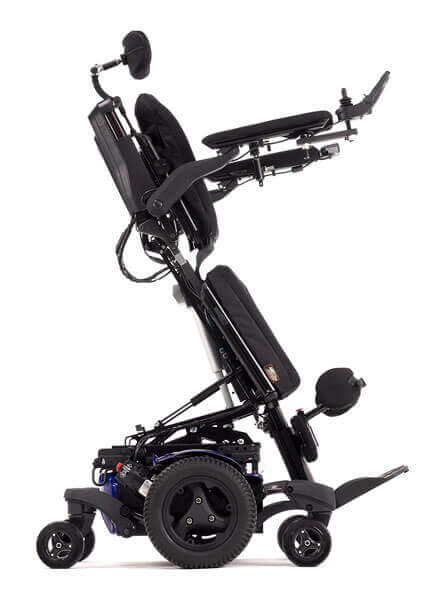Delt:
Take it offline!
This Education in Motion resource is also available as a printable PDF.
Download PDF
Recently I was invited to participate in a follow-up appointment for a client named Errol who was seeking a new powered wheelchair (PWC). The original assessment was pretty standard fare - all parties involved wanted to make sure that we understood Errol's needs from the clinical and functional standpoint, his personal desires, and everyone's (including Errol's) goals. The team completed a thorough evaluation which included reviewing his medical history; discussing his current medical status; and conducting a seating & positioning assessment, a mobility assessment, and equipment trials. Everyone on his treatment team believed a power wheelchair with a standing function would be great for Errol in terms of pain reduction, increased functionality & skin protection, and additional change in position.
However, I wanted to make sure that this standing function didn't impact other aspects of how Errol uses a power wheelchair that he may have come to take for granted, or had not considered.
It's easy to look at power wheelchairs with a standing function and be amazed by the technology. After all, the opportunities an independent, mobile standing position can offer a client, from functional, clinical, and social emotional standpoints, can be life-changing. But we must also consider what our clients need the powered wheelchair to do when it isn't standing, and how postural needs change between standing and sitting. Hence, my participation in Errol's follow-up appointment.
Going into the appointment, I had a checklist of considerations which centered on matching the mobility and usage pattern that Errol had come to expect. The new wheelchair needed to be maneuverable and nimble both inside and out, with the capacity to handle tight spaces and various surfaces that he would encounter at home and on his way to the shops, or even to the next suburb to visit the local park and beach. Another point that came to mind was Errol's ability to manage and control all of the power seat functions and making sure that the wheelchair offered good postural support and comfort in every position.

At the time of evaluation, Errol's power wheelchair was mid-wheel drive (MWD) and he reported no issues with being able to maneuver the wheelchair throughout the environments he frequented. Since Errol was accustomed to driving a MWD chair and expressed satisfaction with that style, it became important to his team and me to ensure his next power wheelchair was also mid-wheel drive. With that information, the team was able to narrow the options of PWCs down further and focus on the QUICKIE® Q700-UP M as a solid contender.
The Q700-UP M turned out to be a bit narrower and shorter than Errol's current chair, which was an added bonus in terms of maneuverability. The Q700-UP M also has the same suspension capabilities in the home position offered in its non-standing counterpart, the Q700 M. The revolutionary SpiderTrac® 2.0 suspension would allow Errol to easily manage his trips around town. So, yes, the Q700-UP M could perform as well as his current mid-wheel drive power wheelchair.
Next, could it support all of our postural goals?
It's tricky to provide postural supports in both seated and standing positions, as our dimensions and muscle control can differ greatly between these two positions. But with some adjustments to arm support height and location, additional lateral thigh supports, and special custom arm pads & elbow blocks, Errol felt supported, confident in the standing position, and was able to transition between standing and sitting. Adjustments made via the Memory Position Programming also enhanced Errol's final standing posture and improved the transition between these positions.
However, the "evidence" that most convinced me? Watching Errol as he so enjoyed the stretch and the relief in discomfort offered by the standing position. Errol felt immediate relief in his trunk and neck discomfort and he came into the standing position. The joy on his face was clearly evident as he moved around in his environment safely and confidently in a full standing position.
This experience also further supported by conviction that a proper assessment and discussion of goals certainly enhances successful outcomes.